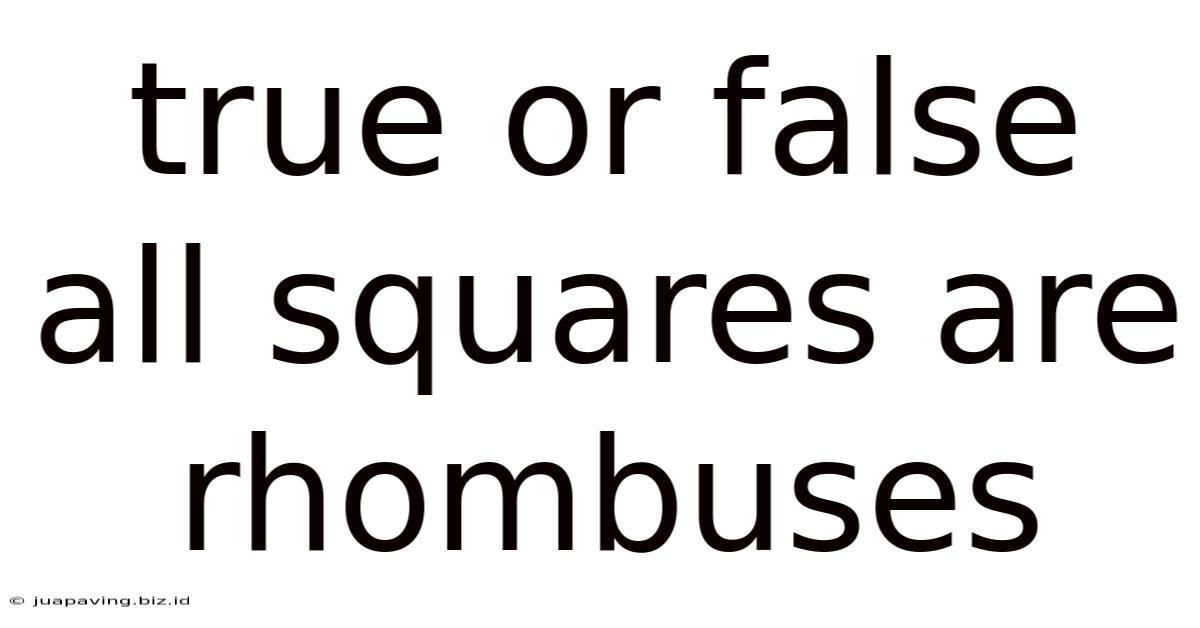True Or False All Squares Are Rhombuses
Juapaving
May 12, 2025 · 4 min read

Table of Contents
True or False: All Squares are Rhombuses? A Deep Dive into Quadrilaterals
The question, "Are all squares rhombuses?" might seem simple at first glance. A quick look at their respective shapes might lead to a hasty conclusion. However, a deeper understanding of geometric definitions and properties reveals a more nuanced answer. This article will delve into the fascinating world of quadrilaterals, specifically squares and rhombuses, exploring their defining characteristics and ultimately answering the titular question definitively. We'll also touch upon related shapes like rectangles and parallelograms to provide a comprehensive overview of quadrilateral classification.
Understanding the Definitions: Squares and Rhombuses
Before we can determine the truth of the statement, we need precise definitions of both squares and rhombuses. These definitions form the bedrock of our geometrical understanding and will allow us to logically deduce the relationship between these two shapes.
What is a Square?
A square is a quadrilateral (a four-sided polygon) characterized by the following properties:
- Four equal sides: All four sides of a square have the same length.
- Four right angles: Each of the four interior angles of a square measures 90 degrees.
- Opposite sides are parallel: The opposite sides of a square are parallel to each other.
These three properties are essential and sufficient to define a square. Any quadrilateral possessing all three is, by definition, a square.
What is a Rhombus?
A rhombus, also known as a diamond, is a quadrilateral defined by:
- Four equal sides: Similar to a square, all four sides of a rhombus have equal length.
- Opposite sides are parallel: The opposite sides of a rhombus are parallel.
Notice the key difference: a rhombus doesn't require right angles. Its angles can vary, as long as the opposite angles are equal (and the sides remain equal).
Analyzing the Relationship: Squares and Rhombuses
Now, let's compare the defining properties of squares and rhombuses:
| Property | Square | Rhombus |
|---|---|---|
| Number of Sides | 4 | 4 |
| Side Lengths | All four sides are equal | All four sides are equal |
| Opposite Sides | Parallel | Parallel |
| Angles | Four right angles (90°) | Opposite angles are equal |
From this comparison, it's evident that a square possesses all the properties of a rhombus. A square has four equal sides and its opposite sides are parallel. Therefore, a square satisfies the definition of a rhombus.
The Answer: All Squares are Rhombuses (True!)
Based on our analysis, the answer is definitively True. All squares are rhombuses because a square fulfills all the criteria required to be classified as a rhombus. However, the converse is not true; not all rhombuses are squares. A rhombus can have angles other than 90 degrees, whereas a square must have four right angles.
Expanding Our Understanding: Parallelograms and Rectangles
To further solidify our understanding, let's briefly examine the relationship between squares, rhombuses, and other quadrilaterals like parallelograms and rectangles.
Parallelograms
A parallelogram is a quadrilateral with opposite sides parallel. Both squares and rhombuses are specific types of parallelograms. This means that all squares and rhombuses inherit the properties of parallelograms, such as opposite sides being equal in length and opposite angles being equal.
Rectangles
A rectangle is a quadrilateral with four right angles. Squares share this property with rectangles. However, unlike squares, rectangles don't necessarily have equal sides. A square is a special type of rectangle where all sides are equal.
Visualizing the Relationships: A Venn Diagram
A Venn diagram can effectively illustrate the hierarchical relationship between these shapes:
Parallelogram
/ \
/ \
Rhombus Rectangle
| |
| |
+-----------------------+
Square
This diagram shows that squares are a subset of both rhombuses and rectangles. All squares are rhombuses, and all squares are rectangles. However, not all rhombuses are squares, and not all rectangles are squares.
Real-World Applications: Understanding Geometric Relationships
Understanding the relationships between squares, rhombuses, and other quadrilaterals has practical applications in various fields:
- Engineering and Architecture: These shapes are fundamental in structural design, ensuring stability and efficiency in buildings and bridges.
- Computer Graphics and Game Development: Understanding geometric properties is crucial for creating and manipulating two-dimensional and three-dimensional objects in computer graphics.
- Mathematics and Physics: These shapes form the basis for many mathematical concepts and physical models.
Conclusion: A Clear and Concise Answer
The statement "All squares are rhombuses" is true. This conclusion stems from the precise definitions of squares and rhombuses and their inherent properties. By understanding these definitions and their relationships, we can confidently navigate the world of geometry and appreciate the intricate connections between seemingly simple shapes. This understanding extends far beyond theoretical mathematics, finding practical applications in various fields of study and everyday life. The hierarchical nature of these shapes – with squares nested within rhombuses and rectangles – allows for a more complete comprehension of geometric principles. This knowledge fosters a deeper appreciation for the elegance and precision of geometric relationships.
Latest Posts
Latest Posts
-
Mass Of 1 Molecule Of Water
May 13, 2025
-
Putting Integers In Order From Least To Greatest
May 13, 2025
-
Which Element Has The Least Metallic Character
May 13, 2025
-
How Many Chromosomes Are Present In A Human Somatic Cell
May 13, 2025
-
Do Birds Have A Four Chambered Heart
May 13, 2025
Related Post
Thank you for visiting our website which covers about True Or False All Squares Are Rhombuses . We hope the information provided has been useful to you. Feel free to contact us if you have any questions or need further assistance. See you next time and don't miss to bookmark.